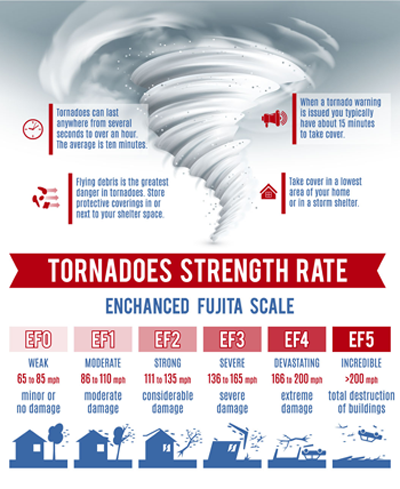
With this said, and in spite of the effectiveness of response, there were over 50 injuries, a figure which may underrepresent the true number of injures as some who are injured may avoid hospital care because they view wounds as minor or lack insurance. Understanding why these injuries came about is critical to preventing deaths and injuries for future events. Was there simply not enough lead time? Did the respondents receive the warnings and understand them? If warnings were received and understood, were victims prevented in some way from seeking shelter or protecting themselves? In addition to effective preparedness, also necessary is a comprehensive understanding of the personal, psychological, and social dynamics at play during periods of severe weather and how these elements either hinder or facilitate preparedness in practice.
What are the likely recovery practices from tornadoes that caused so much destruction across a wide area?KYNE: There are best practices in recovering from tornadoes. Some of the best practices are concerned with structural resiliency. To re-build damaged buildings from tornadoes, it is imperative to incorporate best practices into construction and building a safe room. International Code Council (ICC) 600 provides guidelines for building codes to build in regions prone to tornadoes with a wind speed of 90 mph (3-second gust) to 150 mph. In addition, FEMA P-499, Home Builder’s Guide to Coastal Construction lists series of best practices that could be incorporated into building houses in high-wind regions. Moreover, there are best practices such as FEMA P-804, Wind Retrofit Guide for Residential Buildings that could be used to improve the performance of existing houses.
Another best practice to recovery is to consider building a safe room where residents could evacuate themselves to protect against both wind forces and the wind-borne debris. Other best practices begin with planning for disaster resiliency. In the history, the Canton, Texas is a tornado-prone region with a record of more than 105 tornado events near Canton between 1950 and 2010. In such regions, planning for disaster resiliency is imperative for key stakeholders. The enforcement of the building codes and making sure that existing buildings are resilient to the high-speed wind are necessary actions for concerned authorities. In addition, the safe room should be included in the planning and issuing permission for new building. More importantly, emergency and evacuation plan must be placed in order and they must reflect reality in carrying out timely evacuation when there is a tornado. Risk communication is also important to keep residents informed about the any danger and allow them to evacuate.
How long can the recovery process take from a natural disaster like this?KYNE: This is a good question. I would like to say that recovery varies spatially and temporally. In other words, the time to recover from a natural disaster varies from one region to another and from time to time depending on vulnerability and resiliency to disasters of a given region at a given time. To estimate a recovery from a natural disaster like this, first and foremost, we need a damage assessment. I believe that the damage assessment is in process and we anticipate hearing the estimate soon. In general, tornado rebuilding could take years in severely damaged regions.
Our thoughts are with those affected by the devastating destruction, as well as the families and friends who lost a loved one. A sincere thanks to Dr. Dean Kyne and Dr. William Donner for taking time to speak with IGI Global and sharing their thoughts on not only the tornadoes, but the preparedness, recovery process and impact on the destructed areas. Please take a moment to follow the journal on
Twitter and view the
International Journal of Disaster Response and Emergency Management.
Newsroom Contact:
Elizabeth Leber
Promotions Assistant
eleber@igi-global.com
(717) 533-8845, ext. 132
www.igi-global.com